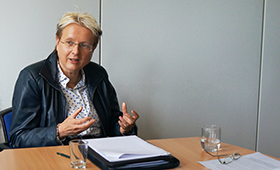When supply and demand no longer match
Interview with Professor Elisabeth M. Krekel and Professor Robert Helmrich
22.10.2015
Despite increasing immigration and rising labour force participation rates, it may not be possible to prevent the impending skilled labour shortage in the medium skills level, that is, among people who have completed initial vocational education and training. While the demand for skilled workers is increasing, the number of trainees is declining. At the same time there has been less and less success in matching supply with demand, and finding a fit increasingly poses a problem. Our editor Katerina Breuer discussed this topic with the relevant experts in the BIBB, Professor Elisabeth M. Krekel and Professor Robert Helmrich.

BIBB: Numerous vacant training places on the one hand and a large number of unsuccessful candidates on the other hand testify to a problem with fitting in the training market. How has that come about?
Krekel: On the one hand it is because the young people are inclined towards certain occupations and other occupations stand less of a chance. We assume that this trend will continue in the coming years as well. On the other hand, the recruiting behaviour of companies is also a factor. In times of high demand, the companies were able to pick and choose from among the young people. The question now is this: How do they manage to appeal to the young people whose school performance has perhaps not been so good.
BIBB: Is the fact that more and more young people acquire university entrance qualifications and then go on to higher education a reason for the current situation as well?
Krekel: Yes and no. The fact that more and more young people acquire university entrance qualifications and then make use of them does of course have an influence on young people being less and less available as a clientele for dual vocational education and training. For those entitled to take higher education, industrial occupations or occupations in the crafts are less attractive. They turn more to service occupations, where they compete with one another and with others.
"By fitting problems we mean a lack of correspondence or a mismatch between the demand for appropriate vocational education and training as well as job opportunities and the supply of training places and jobs." Source: Data Report of the 2015 Vocational Education and Training Report
BIBB: Can a similar trend be observed in the labour market?
Helmrich: Demographic bottlenecks and altered qualification behaviour affect the training market first. They become increasingly visible in the labour market after a time lag of about 15 years, mostly when the baby boomers leave the labour market. Right now we have no consistent bottlenecks or actual fitting problems between supply and demand for different skill sets and occupations. What we do have is rather a situation in which we have hiring problems in specific regions. In the long term, however, the situation that prevails in the market for training places will leak through to the labour market. If the companies cannot train anyone in certain occupations because there are no applicants there, sooner or later they will have problems finding the skilled workers they need. How dramatic the situation is depends on the region. In the northern federal states, we have major problems in the crafts and certain service occupations. In the southern federal states, we have problems mostly in the industrial and engineering occupations and in the public health sector. We still have a sufficient supply in most occupations, especially if the companies manage to arrange for people to work as much or as little as they want and to ensure a better work-life balance. In the medium and long term, however, the labour market will run into a bottleneck, especially where training no longer takes place.

BIBB: In which areas can fitting problems already be found in training?
Krekel: We have regional and occupation-specific disparities in training. In some regions, such as the Ruhr region, there are more applicants than training places. In other regions, such as Bavaria, there are more unfilled training places. From the occupation-specific point of view, we see the problems concentrated in the crafts as well as in the tourism, hotel and restaurant trade.
BIBB: How about the labour market?
Helmrich: We have the most bottlenecks in the labour market in the health sector and the traditional technical occupations as well as in the hospitality industry and in the transport-related occupations, that is, storage and transport. In the latter two cases because too little training is done there to meet the demand. Moreover, there are very many people with unrelated qualifications as well as unskilled people working in the catering sector and the transport-related occupations. If these people see other opportunities in the labour market or the chance to work in their original occupation, they will not go into the hospitality industry or into the transport-related occupations as non-specialists in the future. We have some very pronounced regional differences in the public health occupations. No long term bottlenecks can be seen in the north and west, because with the structural change there more emphasis has been placed on those trades. We have more bottlenecks in the south, however, and they are going to grow in the coming years. The way the respective regional economy positions itself and accordingly trains or has trained determines in part whether there is a bottleneck or not. That there is always talk of bottlenecks in the so-called STEM occupations (science, technology, engineering and mathematics) has to do with the fact that many who have learned a STEM occupation move into other jobs because they offer higher incomes or a better chance of reconciling work and family life.
BIBB: So what makes some occupations more attractive than others?
Helmrich: Wages is a very central criterion for the attractiveness of an occupation, in addition to working conditions, career opportunities and the prestige that a job brings with it. In the health professions, for example, the prestige is very high but the framework conditions tend to be discouraging.
Krekel: It is much the same in training. The remuneration is one indication among others of the attractiveness of an occupation. Occupations have a certain image, they go down more or less well with friends and family. And occupations definitely compete with one another. Another question that comes up when choosing a career is which occupation is attainable with which school leaving certificate. If you look at the occupation of cook, for example, you see that this is one of the frequently chosen training occupations, although we have a high contract termination and vacancy rate there. This is due on the one hand to the working conditions the job brings with it. On the other hand, however, it is not perceived as unattractive and the public perception of it is enhanced by the media coverage, for example in cooking shows.
I assume that the fitting problems will persist in the training market.
BIBB: Will the situation be exacerbated in the future?
Helmrich: I don't know how the situation will actually develop up to 2030. Our projections are guesswork as to how the situation will develop, based on the past figures that we have. In the BIBB-IAB Qualification and Occupational Field Projections we look at what the past says, what the present says and what will happen if we project existing relationships. So we arrived early at the assertions, for example, that we will have a university graduate overhang and that the shortages will be in the technology occupations, not the STEM occupations. This prediction is now shared by others as well. Many changes can influence it. Key words such as "Economy 4.0" are of course developments that might lead to a completely different job structure in the labour market. As things stand, the situation will worsen, especially after 2030, because then there will be a real collapse in the demographics. You have to keep your eye on the ball at all times. That is why we update our projections every two years. Not because we don't believe them but because parameters – for example, the labour force participation rates of older people and women – can change relatively quickly in the labour market. One recent example was the huge economic and financial crisis in 2008, which had a quite different impact in Germany than in other countries. The next will be the economic development in digitisation and of course above all the large number of refugees.
Krekel: I would also say that it is of course difficult to predict. But I assume that the fitting problems will persist in the training market.
BIBB: Has the dual system become less attractive?
Krekel: The dual system of vocational education and training continues to be the core of the education system in Germany and a mainstay of the German economy. While the dual system of vocational education and training on the German model is admired in other countries, we in Germany have been talking for years about its unattractiveness. The dual system of vocational education and training is closely coupled with the economic system and therefore dependent on economic development as well. It is the poster child and the royal road to meeting the demand for skilled workers in Germany. Networking between trainers and employers guarantees orientation towards demand. The higher education system can never provide a perfect fit, which means too that the training it provides may fail to meet the social and/or economic needs. Dual study programmes are supposed to mitigate this risk, and higher education institutions all put their emphasis on practice phases. Nevertheless, we have to acknowledge that other, non-dual education programmes such as academic studies are more attractive to those with a higher level of schooling. And: Parents who have a university education themselves generally want their children to be university graduates as well. Many university-educated households see dual vocational education and training as an educational step down, and that is not what parents want for their children.

Helmrich: For many the goal is now the Gymnasium (upper secondary school) and the university entrance qualification. At the moment we have a strong inflow into the higher education sphere and it is still rising. Those who go into higher education are ultimately absent as vocationally qualified persons from the labour market. We shall see whether the labour market really needs that quantity of university graduates. The coming years will show whether the university graduates will have to compete for jobs with others who have completed vocational education and training, to work outside their field or to reckon with extended periods of unemployment. I sometimes have the hypothesis on my lips that we might see a cattle cycle in which the adaptation of supply to demand is always somewhat delayed. At the moment the trend is increasingly towards the academic system. Perhaps the pendulum will swing in the other direction again, and we will say that a solid vocational qualification is definitely a basis on top of which one can always put a course of academic study.
BIBB: Does the lack of skilled labour also have its positive aspects?
Helmrich: There is always something positive about a skilled labour shortage from the viewpoint of the employees, for their interpretation will be: "I have a better chance of finding an attractive job with higher wages and more attractive working conditions." In principle it is more difficult at first for the companies, because it is not so easy for them to find suitable employees. On the other hand it also means that the companies are much more mindful of how they treat the capital they have in their employees. They will try to keep their skilled workers on the job longer, for example through health management, further education and similar measures. In future, skilled workers will also be capital that cannot be simply replaced by market mechanisms.
Krekel: I only partly believe that, because every opportunity harbours dangers as well. In the context of the skilled worker shortage, these could lie in the greater digitisation of the world of work that is now being discussed under the heading of "Economy 4.0". As a consequence there is the danger that jobs could be lost.
Digitisation will, I believe, lead not to a massive destruction of jobs, but to a change in activities.
Helmrich: I would dispute that. Digitisation will, I believe, lead not to a massive destruction of jobs, but to a change in activities. The automation wave has tried to replace by machines those activities that had high degrees of routine. But ultimately that has not meant that we have shed jobs. Instead, we have even more jobs now. I believe that will happen in the digitisation era as well. What will happen is that occupations will change. The differences between the industry sectors will change. Certain sectors, certain jobs will grow while others will recede. It may be that, owing to the bottleneck, we will not have precisely the qualification that is needed. At that point we need to respond quickly to the new requirements that the digitised, globalised world confronts us with.
BIBB: Currently numerous refugees are arriving in Germany every day. Can these people help improve the situation in the training and labour markets?
Krekel: Previous projections have assumed the traditional migration gain and migration loss of 100,000 and 200,000 people respectively. The balance is those who have permanently crossed the border to Germany minus those who have permanently left Germany. But now we are confronted with an entirely new situation. In the current situation, with the problems changing every day, I would warn against making any predictions. Very many questions are still unanswered. Not only how many people are coming to Germany as refugees, but how many are going to stay in Germany? How will the stays in Germany be regulated? How old are the refugees? What educational and vocational qualifications do they bring with them? These are all questions that we cannot answer at present, but that we urgently have to tackle.
BIBB: Are there any studies on these questions yet?
Helmrich: The current data situation is not yet representative and not very reliable with regard to the qualification structures of immigration. Another point is that we do not know how long the inflow of refugees will last. The issue at the moment is crisis management. It is a question of the possibility of integrating the refugees at least socially. And then little by little comes the big job of integrating them into the labour market, and that means integrating them vocationally. I am confident we will succeed in that. But how long it will take no one can say. For the labour market, you basically have to say that due to demographic developments a higher rate of immigration is advantageous for Germany and also makes economic sense. But their integration into the labour market has to succeed, otherwise it makes no sense for either side.
Prof. Dr. Elisabeth M. Krekel is head of the Department „Sociology and Economics of Vocational Education and Training“ at BIBB
Prof. Dr. Robert Helmrich ist head of the Division „Qualifications, Occupational Integration and Employment“ at BIBB